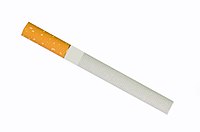
Photo from wikipedia
Noninvasive fluorescence (FL) imaging and high-performance photocatalytic therapy (PCT) are opposing optical properties that are difficult to combine in a single material system. Herein, we report a facile approach to… Click to show full abstract
Noninvasive fluorescence (FL) imaging and high-performance photocatalytic therapy (PCT) are opposing optical properties that are difficult to combine in a single material system. Herein, we report a facile approach to introducing oxygen-related defects in carbon dots (CDs) via post-oxidation with 2-iodoxybenzoic acid (IBX), in which some nitrogen atoms were substituted by oxygen atoms. Unpaired electrons in these oxygen-related defects rearranged the electronic structure of the oxidized carbon dots (ox-CDs), resulting in an emerging near-infrared (NIR) absorption band. These defects not only contributed to enhanced NIR bandgap emission but also acted as trappers for photoexcited electrons to promote efficient charge separation on the surface, leading to abundant photo-generated holes on the ox-CDs surface under visible-light irradiation. Under white LED torch irradiation, the photo-generated holes oxidized hydroxide to hydroxyl radicals in the acidification of the aqueous solution. In contrast, no hydroxyl radicals were detected in the ox-CDs aqueous solution under 730 nm laser irradiation, indicating noninvasive NIR FL imaging potential. Utilizing the Janus optical properties of the ox-CDs, the in vivo NIR FL imaging of sentinel lymph nodes around tumors and efficient photothermal enhanced tumor PCT were demonstrated. This article is protected by copyright. All rights reserved.
Journal Title: Advanced materials
Year Published: 2023
Link to full text (if available)
Share on Social Media: Sign Up to like & get
recommendations!